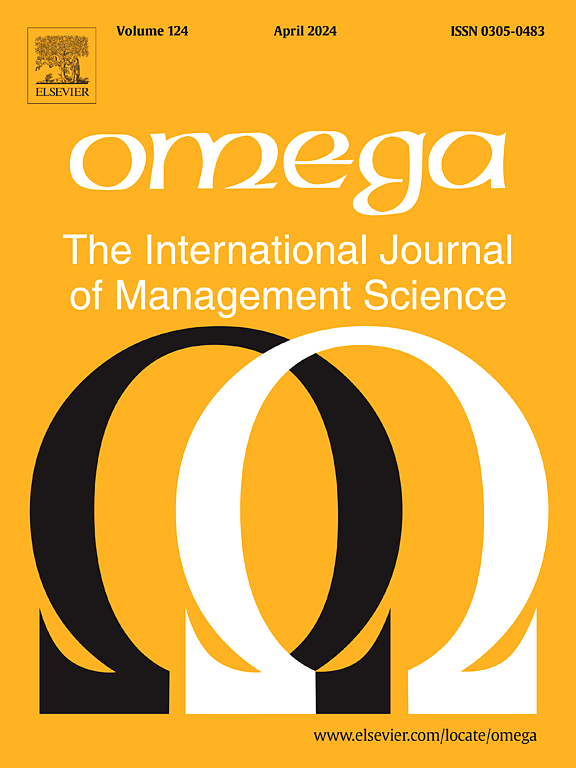考虑设防失效概率的稳健设施选址与设防
IF 7.2
2区 管理学
Q1 MANAGEMENT
Omega-international Journal of Management Science
Pub Date : 2025-05-08
DOI:10.1016/j.omega.2025.103357
引用次数: 0
摘要
考虑供应链(SC)的可行性是通过重新设计结构和重新规划具有长期影响的绩效,在不断变化的环境中维持自身和生存的能力。本文研究了供应链网络中针对供应设施中断和设防失效的设施选址和设防问题,其中设防失效概率服从二项分布(BD)、0-1均匀分布(UD)和未知分布但近似为正态分布(NDA)。建立了具有决策依赖不确定性的3个两阶段鲁棒优化模型(TSRO-DDU),对失效概率下具有BD、UD和NDA的FLFP问题进行了建模。提出了将TSRO-DDU模型等效转化为具有决策无关不确定性的两阶段优化模型(TSRO-DIU)的理论性质。为了准确求解TSRO-DIU模型,提出了一种改进的列约束生成算法,以处理设施破坏和设防失效的双线性不确定性。数值实验表明了考虑设防决策和设防失效概率的重要性。此外,与不设防模型(NFM)、经典成功设防模型(CFM)和确定性设防失效模型(DFM)相比,我们证明了TSRO-DDU模型在随机攻击和设防失效场景下的灵活性。我们还通过考虑设施中断风险后的设施恢复决策来扩展模型。总体而言,本研究扩展了考虑设防失效概率的设施选址和设防问题,可以战略性地帮助管理者在复杂和不确定的环境中设计一个有弹性和可行的供应链网络。本文章由计算机程序翻译,如有差异,请以英文原文为准。
Robust facility location and fortification considering fortification failure probability
Considering the viability of a supply chain (SC) is the ability to maintain itself and survive in a changing environment through a redesign of structures and replanning of performance with long-term impacts. This paper considers facility location and fortification problem (FLFP) in supply chain network against supply facility disruptions and fortification failure, where the fortification failure probability follows a binomial distribution (BD), a 0-1 uniform distribution (UD), and an unknown distribution but a normal distribution approximation (NDA). Three two-stage robust optimization model with decision-dependent uncertainty (TSRO-DDU) models are developed to model the FLFP problems under failure probability with BD, UD, and NDA. Some theoretical properties are developed to transform TSRO-DDU models equivalently into two-stage optimization models with decision-independent uncertainty (TSRO-DIU). To solve the TSRO-DIU models exactly, an improved column-and-constraint generation algorithm is developed to deal with the bilinear uncertainty of facility disruption and fortification failure. Numerical experiments are conducted to show the importance of considering fortification decisions and fortification failure probability. Furthermore, we demonstrate the flexibility of the TSRO-DDU models under random attack and fortification failure scenarios, compared with the no-fortification model (NFM), the classic successful fortification model (CFM), and the deterministic fortification failure model (DFM). We also extend the models by considering facility recovery decisions after the facility disruption risk. Overall, this work extends the facility location and fortification problems considering the fortification failure probability and can strategically help managers design a resilient and viable supply chain network in a complex and uncertain environment.
求助全文
通过发布文献求助,成功后即可免费获取论文全文。
去求助
来源期刊

Omega-international Journal of Management Science
管理科学-运筹学与管理科学
CiteScore
13.80
自引率
11.60%
发文量
130
审稿时长
56 days
期刊介绍:
Omega reports on developments in management, including the latest research results and applications. Original contributions and review articles describe the state of the art in specific fields or functions of management, while there are shorter critical assessments of particular management techniques. Other features of the journal are the "Memoranda" section for short communications and "Feedback", a correspondence column. Omega is both stimulating reading and an important source for practising managers, specialists in management services, operational research workers and management scientists, management consultants, academics, students and research personnel throughout the world. The material published is of high quality and relevance, written in a manner which makes it accessible to all of this wide-ranging readership. Preference will be given to papers with implications to the practice of management. Submissions of purely theoretical papers are discouraged. The review of material for publication in the journal reflects this aim.
 求助内容:
求助内容: 应助结果提醒方式:
应助结果提醒方式:


